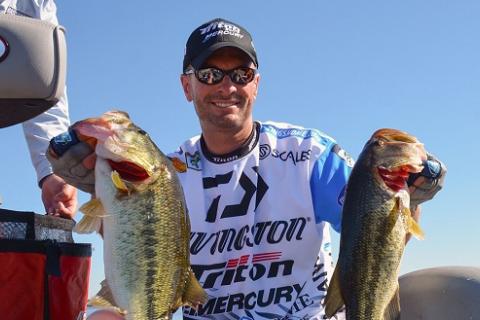
by Pros4- 1Source's Dave Landahl
Fishing jigs: almost as basic as a hook and a weight to use for catching fish. Essentially, a jig is a form of a weighted hook with some attractant built onto it (hair, silicon, rubber, etc.). Simple, and in the hands of a knowledgeable angler, very effective for catching fish.
Now, the upgraded version of the basic jig is the current bass jig. Pretty much the same weight and hook concept, but with the living rubber skirt. Add a soft plastic trailer, and you have one of the top go-to lures in almost every professional bass angler's arsenal.
So, let's simplify the jig even further. Instead of pitching or casting it and having to perform specific dragging, or hopping precise retrieves, let's swim it. Yep, cast it out and reel it in. Seriously, that simple- and it works.
Of course, you'll need to vary your retrieve to figure out exactly what the bass want on any given day, but it's a darn good dummy bait and one heck of an offering to use under a variety of conditions.
You can fish a swim jig deep or shallow. The swim jig excels in weedy cover, but is just as effective along wood or rocks.
The simple approach is preferred by two-time Bassmaster Elite Series Angler of the Year Greg Hackney.
"I love fishing with swim jigs because they are so effective," said Hackney. "The basic approach is to simply cast it out and wind it. That is especially true in colder water. Obviously, you'll need to vary your retrieve at times, but I start out with the basic steady retrieve. From that point, you can vary what you do.
"You can pop it and rip it through shallow vegetation and cover, slow-roll the jig like a spinnerbait down deep, or pitch it under docks. You can fish a swim jig almost anywhere bass live in the country."
Hackney's jig choices are kept to a minimum.
"Most of the time I am using a Strike King heavy cover jig," said Hackney. "The trailer is usually a Strike King Rage Craw. Sometimes I use a small swimbait if the bass are on shad. I will use the standard swim jig sometimes when I am fishing colder water with less cover.
"Colors are easy. Bluegill, green pumpkin and the like are what I always have. Also, black and blue early in the morning or when it's really cloudy. These colors work anywhere. If the water is really dark, I may have one with some chartreuse in it. If I am fishing bass feeding on shad, then a shad color like white or a similar color is the way to go."
Water clarity doesn't dictate the line Hackney uses for swim jigs.
"I don't believe bass are line shy," said Hackney. "You need to adjust what line you use based on how a lure performs using the line. This is true with swim jigs for sure. I almost always use braid, whether the water is gin clear or muddy. It is a moving bait, bass aren't fixated on the line.
"The only time I will use fluorocarbon for swim jig fishing is when the water is colder and I need to fish slower and deeper. It has to do with the action of the jig on the lighter line and not the fish reacting to the line."
Anybody can and should fish swim jigs according to Hackney.
"If you can cast and retrieve you can fish a swim jig," said Hackney. "Seriously, if you are fishing spinnerbaits now you have the ability to fish a swim jig. It is such a versatile lure. Every bass angler should use them. I like the simplicity of fishing it. I always have one tied on. It is a really cool bait."
Former Bassmaster Classic champion Randy Howell loves swim jigs as well.
Howell isn't just casting and retrieving slowly like many anglers who fish a swim jig. He likes to get the lure moving. Braided line is a key element to his power swim jigging.
"You need to use braided line for power swim jigging," said Howell. "I use 65-pounded braid, and I match that with a heavy Daiwa casting rod and fast retrieve reel.
"That setup is excellent for being able to move the jig fast. Has plenty of power to move a big fish out of cover and is not so big that I can't twitch and pop the rod effectively to get that jig moving properly.
"One more thing about the braid that is important is that it is key to attracting fish. It makes a clicking noise by the jig when you pop it. I believe that sound will draw many fish to the jig. Make sure you are using braid."
No need for a special swim jig when using the power swim jig method.
"I use a regular 3/8-ounce Lunker Lure jig," said Howell. "I use the jig with a 5/0 hook and a single rattle. I like that jig because it has a flat bottom on the head and it planes out and stays up in the water easier than the bullet heads associated with most swim jigs.
"I use either a white jig in stained water with a Yamamoto single or double tail trailer. Sometimes a green pumpkin trailer for contrast.
"In clearer water, I use a bream colored jig with the Yamamoto trailers to match.
"The double tail is better in cooler water. The single is better when I want to move it faster.
"I may not always be fishing the power swim jig method, but I always have one handy. I'm always trying it when I start out fishing in shallow water. When that bite is on, you can get big fish. It's fast and easy and a very high percentage of hookups turn into fish in the boat."
- 14740 views

